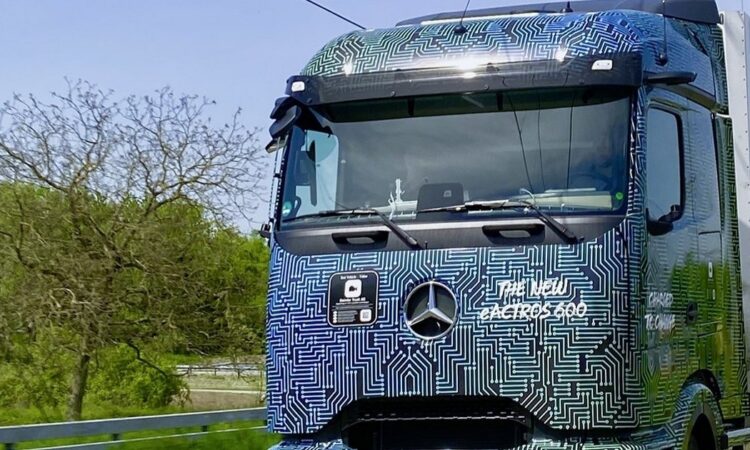Leinfelden-Echterdingen – A battery-electric Mercedes-Benz eActros 600 recently started operations along the B462 road in the Northern Black Forest for the logistics company Fahrner. As part of the “eWayBW” project under the leadership of the Baden-Württemberg Ministry of Transport, the near-series e-truck prototype is being deployed alongside the catenary truck from another manufacturer in a technology comparison. For this comparison, the eActros 600 is transporting paper products over a distance of around 18 kilometers between the paper mills in Gernsbach-Obertsrot and Fahrner’s logistics location in Kuppenheim, covering around 220 km each day. The eActros 600 is charged overnight at a charging station that was installed at Fahrner’s depot for the duration of the project.
Daimler Truck is not planning to develop catenary trucks. For its vehicle strategy, the manufacturer is building on batteries and on hydrogen, i.e. on locally CO2-neutral drive technologies that can be deployed flexibly.
Martin Daum, CEO Daimler Truck AG: “We are clearly committed to the climate targets. To reach these targets, politics and industry must focus on those technologies that really lead the way forward for emission-free transportation. Only by doing so, we can ensure efficient use of our resources and budgets. In recent years, we have succeeded in putting more than 6,000 e-trucks on the road, each one working every single day for our customers. The eActros 600, the model called on to compete with the catenary truck in the technology comparison, is our first battery-electric long-distance haulage truck. Since the start of sales at the end of last year, we have already received more than 1,000 fixed orders. This shows that we are on the right course with our drive strategy. We are convinced that our eActros 600 will prove itself on the Murgtal Valley route.”
Independently of “eWayBW” Daimler Truck has been successfully underway on the B462 road since 2019 with various generations of the battery-electric eActros – from the first prototype through to the series version of the eActros 300 distribution transport variant – in various practical applications at logistics company Schmitt.
The Mercedes-Benz eActros 600 in series production
The high battery capacity of more than 600 kilowatt hours – hence the model designation 600 – and a new, particularly efficient electric drive axle developed in-house, enable the e-truck to achieve a range of 500 kilometers[1] without intermediate charging. This means the eActros 600 will be able to travel significantly more than 1,000 kilometers per day. This is made possible by intermediate charging during the legally prescribed driver breaks – even without megawatt-charging (MCS).
In addition to CCS charging with up to 400 kW, the eActros 600 will later also enable megawatt charging. This April, developers from Mercedes-Benz Trucks successfully charged for the first time a prototype of the eActros 600 at a charging station with an output of one megawatt at the in-house development and testing center in Wörth am Rhein. Customers can order a pre-installation for MCS. As soon as MCS technology becomes available and is standardized across manufacturers, it is planned to be retrofittable for these early models of the eActros 600. The batteries can be charged from 20 to 80 percent in about 30 minutes at a suitable charging station with an output of around one megawatt.[2]
When it comes to profitability for fleet operators, the electric truck is intended to set new standards, over the long term replacing the majority of diesel trucks in the important long-haul transport segment. The core of Mercedes-Benz Trucks’ concept for battery-electric long-distance transport is to offer customers a holistic solution consisting of vehicle technology, consulting, charging infrastructure and services.
The launch of series production is planned for the end of 2024. In addition to the tractor unit, Mercedes-Benz Trucks will also produce rigid variants of the eActros 600 right from market launch, offering customers further possible applications for electric transport.
[1] The range was determined internally under specific test conditions, after preconditioning with a 4×2 tractor unit with 40t total towing weight at 20°C outside temperature in long-haul operation and may deviate from the values determined in accordance with Regulation (EU) 2017/2400.
[2] Based on internal simulations since a binding and uniform Megawatt Charging System (MCS) standard is currently under development.
Brummionline


